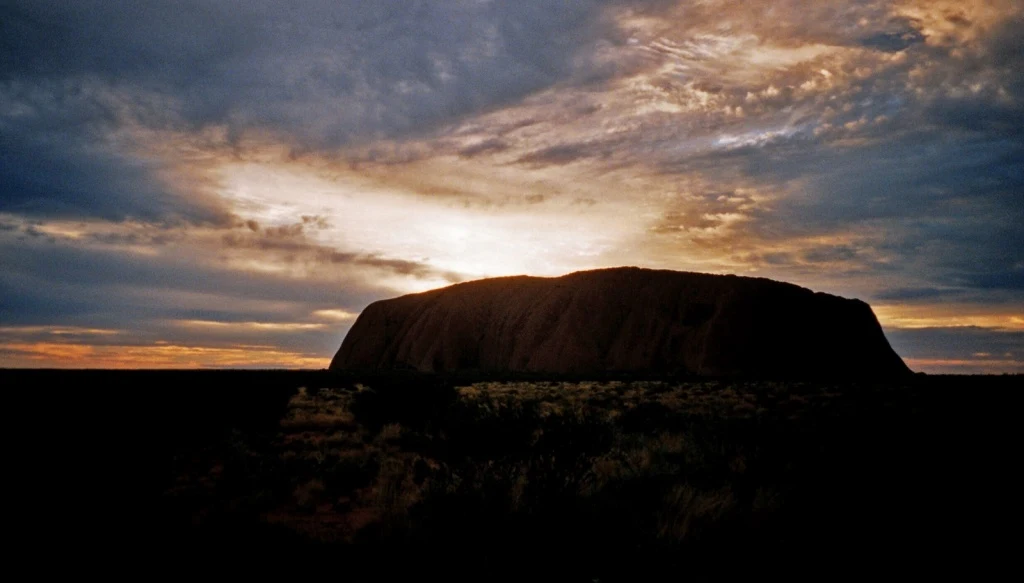 |
Uluru, also known as Ayers Rock, is a redstone monolith overlooking northern Australia. It is revered by the aborigines as a holy place and sticks out on the flat plain like the dorsal fin of a huge red whale.
This mysterious peak boasts a great deal of history for every century of the many millions of years of its existence. Uluru, together with the nearby rocky formation Kata Tjuta ("Many Heads") since 1977, have been part of the Kata Tjuta National Park.
 |
| Uluru Australia |
Mount Uluru in numbers
- Uluru, also known as Ayers Rock, is 3.4 km long and 2 km wide. Its perimeter is about 9 km.
- The visible part of Uluru rises 348 m above the plain, but about 6000 m of this rock formation is hidden below the surface. The maximum height above sea level is 869m.
- Uluru consists of red sandstone formed 600 million years ago.
- Uluru was included in the UNESCO World Heritage List in 1987.
General information
In 1985, the Australian government officially returned both of these complexes, Uluru and Kata Tjuta, to the Northern Aboriginal Territories. The national park is located on their sacred land, in the place where, according to their concepts, life itself originated.
 |
| Uluru Australia |
Uluru can only be considered a geographical miracle because of its size. The red sandstone monolith protrudes 348 m above the plain on average, and its highest point is 869 m above sea level. The visible part of the mountain is 3.4 km long and 2 km wide. Its perimeter is about 9 km. The monolith was formed about 680 million years ago, pushed out from the bowels of the Earth under tremendous pressure. Tectonic activity pressed clay and gravel and pushed them to the surface.
Uluru Rock is formed by almost vertical layers of extremely hard sandstone, the surface of which has turned red as a result of oxidation. From the northwestern and northeastern sides, erosion has cut deep channels in the rock, from where water gushes during the rains - this is how spectacular, but short-lived waterfalls are obtained.
 |
| Uluru Australia |
Most tourists try to climb to the top, although the locals would prefer it not. Every year someone dies, and others have to be saved. There are wonderful views from the plateau at the top of the cliff, it is interesting to explore the top, but the ascent is very difficult, and if strong winds blow, sometimes the trail has to be closed. The length of the route around the cliff is 9 km, perhaps it is worth going along it and seeing various places associated with the Anangu culture.
Like islands in the ocean, the Kata Tjuta complex floats on the horizon 50 km from Uluru. Ernest Giles was the first European to see Kata Tjuta in 1872. He named these mountains "Olgas", in honor of Queen Olga of Württemberg, the patroness of science and art in the 19th century.
 |
| Uluru Australia |
Kata Tjuta is clearly younger than Uluru, they are only 300 million years old. These rocks are not composed of red sandstone like Uluru, but many tightly compressed layers of gravel, cemented by sand and clay. Fragments of granite, gneiss and volcanic rocks can be found among the forming rocks.
The local Anangu tribe considers both Uluru and Kata Tjuta sacred places, where in ancient times the battle between the serpent-people took place. They tell about the python woman Kuniya, who crawled to Uluru to lay eggs. When she finished laying, she heard that a poisonous lyre, a brown snake, had killed her nephew. Wanting to take revenge, Kunia crawled to the foot of Uluru, to a place called Mutityulu.
There she met one of Lyra's servants. She tried to enchant him with a dance, but the servant laughed at her. In anger, she grabbed a handful of sand and threw it on the ground. And where grains of sand fell, trees and grasses became poisonous. But the servant Lyru kept laughing. Finally Kunia grabbed her stick (wana) and hit him on the head. Her rage was so great that the second blow killed the servant Lyra. The deep dents from the blows of her stick are still visible on Uluru - they are embedded in the stone. Cunia and her nephew have turned into rainbow snakes. They still live in Mutityulu and look after the Anangu tribe.
 |
| Uluru Australia |
Anangu, like most Australian aborigines, believe that the earth is the physical manifestation of Sleep (Tjukurpa) - the timeless moment when the world was created. At this time, the spirits of the ancestors lived on earth in the guise of people and animals. Some of these spirits crawled out of the earth in the form of giant snakes, and it was they who gave the planet its current shape. The ancestral spirits also gave the laws that the anangus follow to this day.
Thus, these ancient beliefs are an important part of the spiritual culture for the Aborigines. Aboriginal people believe that the sacred place of Uluru is endowed with special power, it is the door between the world of people and spirits. Anangu never ceases to warn that Uluru takes human lives to this day and that those who climbed the mountain are not good at it. Someone does not believe these legends, but the regular mysterious cases of wicked tourists confirm.